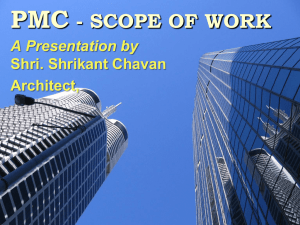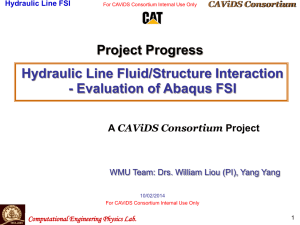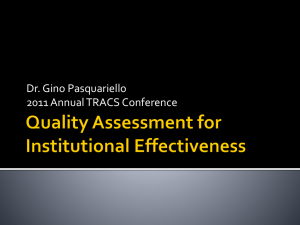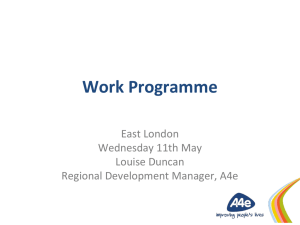Presentation on FSI
advertisement
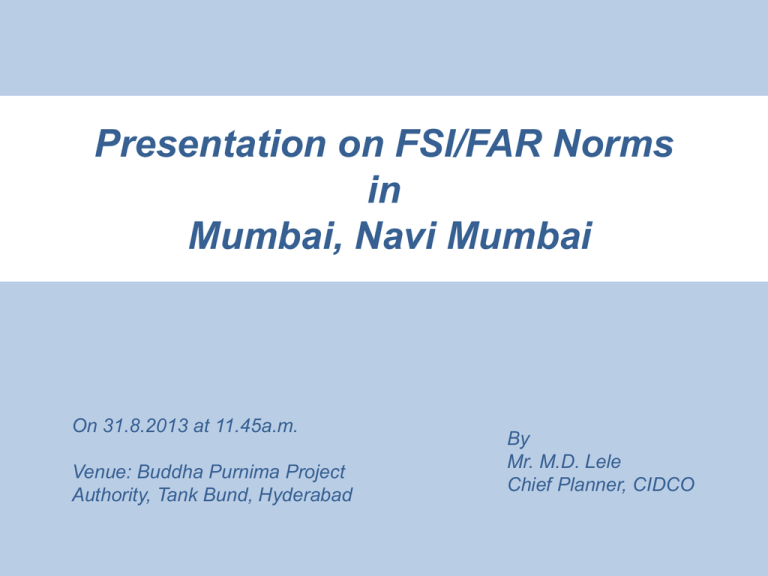
Presentation on FSI/FAR Norms in Mumbai, Navi Mumbai On 31.8.2013 at 11.45a.m. Venue: Buddha Purnima Project Authority, Tank Bund, Hyderabad By Mr. M.D. Lele Chief Planner, CIDCO Table of Contents I. Background II. Computation of FSI III. Incentive FSI IV. Versatile tool V. Constraints VI. Conclusions VII. Green Initiatives Background The meaning- Concept- Origin – FAR FSI => Floor Space Index FAR => Floor Area Ratio’ (term particularly followed in North Indian States) Definition: Floor area ratio is the ratio of a building's total built up area on all floors to the area of plot upon which it is built. plot Gr. coverage FSI : 1 FSI is of little concern • Land extensive uses - Golf Course • Paramilitary forces campuses • Educational campuses • Holiday resorts • Container Yards • Warehouses • Manufacturing plants/Industries • Freight stations • Outdoor Studios • Theme parks Due to handling of heavy goods, availability of large open spaces is required. Built form The built form can be developed in either of the following density patterns 1. Low rise low density 2. Low rise high density 3. High rise low density 4. High rise High Density Computation of FSI Features covered in computation of FSI Without paying premium FSI exemptions granted for the following: (upto certain limits) I. Building features (Basement or cellars, Balcony, Flower bed, Cup boards of limited size, Stilts used for parking where there are no side walls on three or more sides, Architectural features) II. Amenities (Parks, Swimming pools, Society Office, Fitness centre, Club House) III. Utilities (Roads, Electrical, Gas Supply, Water, Sewage, Communication, Parking, Staircase, Watchman’s booth, lifts, fire lifts, fire staircase) Excess area is counted in FSI. Typical violations: •Covering balconies, terraces, flower beds. •Cupboards made part of habitable room •Privatizing common passages etc. •Basement area misused. Parking area used for office and other services Fungible FSI (MCGM SRA) Compensatory floor space index - Interplay of/Mutually interchangeable building features. Upto 35% (0.35) FSI for Balcony, staircase, Terrace, Cupboards, Flower beds are availed as fungible FSI in case of residential use on payment of premium to the authority. 20% fungible FSI can be availed for commercial and industrial development Fungible FSI is usable as regular FSI Manipulations and violation in provision and use of free of FSI components avoided due to concept of Fungible FSI Fungible FSI' would pave way for better transparency in the sector and would also reduce corruption. FSI prescriptions 1. R ……………1.0 2. R+C…………1.0 (for plots of area below 1000 sqm.), 1.5 (for plots of area above 1000 sqm.) 3. C ……………1.5 (starred category residential hotels in any zones other than RPZ) 4. SF……………1.0 5. Industrial…….0.5 -1.0 6. Assembly……1.0 (0.1- 0.15 for assembly in RPZ, 0.05 for cremetoria /burial grounds) 7. Other uses in RPZ…….(0.1 to 0.15) 8. Airport & allied activities…..max. permissible FSI 1.0 FSI for Gaothans Village settlements …….0.75 Granting additional FSI on premium payment i. IT Parks, Religious buildings, Biotechnological Industrial Units (100% additional FSI may be permitted) (50% of religious) ii. Residential use to Residential + Commercial (plot size >1000sq.m.) leased earlier with lower FSI in zones other than predominantly Commercial Zone and provided further GDCR including parking are fulfilled. (50%) iii. Star category Residential Hotels 100% in zone other than RPZ iv. Change of Land use Commercial to R+C or vice-a-versa (min. Plot area 1000sq.m., deriving access from 15m or more wide roadFSI remains 1.5 in both the cases) v. Medical, Educational, Government buildings – 100% Relaxation in marginal open spaces for FSI consumption - For smaller plots Hardship cases- FSI cannot be fully consumed due to odd/ narrow plot shape and size - Airport influence areas Height restriction as per the obstacle limitation map for area around airport, hence FSI cannot be fully consumed.(low rise, high density) Incentive FSI Inducement / Incentive with a purpose • Compensation towards land acquisition • Road widening • Scenic Easements • Promoting Growth Centre activities like IT parks, business parks, facilities like health, education, hotels, religious, commercial etc. • Land Pooling – Eligibility on gross plot area but incentive on net plot area • Heritage conservation Inducement / Incentive with a purpose • Urban Redevelopment / Renewal / Slum Redevelopment • Cluster Development for intensification, (organised development with facilities) • Promoting / subsidising affordable housing • Special Townships • Rental Housing • In lieu of sharing social / physical infrastructure providing responsibility Versatile tool Tapering FSI towards periphery Suitable for metropolitan areas Concept is to have variable FSI. Higher FSI in the city centre and progressive reduction / tapering for area away from it. It meansHigher densities in Central Business District and Residential area adjacent to it and tapering of densities as we move towards suburbs. Taller buildings near commercial area/transit places (TOD) and gradual tapering towards residential areas Variable FSI across the city pockets Based on City vision, assignment of specific land uses/promoting/ restricting certain activities. Global FSI FSI reckoned on large land holding with variations across sub sets (Special Townships) High FSI zones Certain areas are earmarked with high FSI …..3 to 5 Leads to intensification of land utilization for precious and scarce urban land. Prescribed at vantage locations. FSI for dilapidated/unsafe buildings Residents in smaller tenements apparently unable to afford repair, leading to dilapidation. Faced natural calamity, fire hazard. • MCGM provision For the Redevelopment or Reconstruction of Old Cessed Buildings, the Government of Maharashtra has already approved a Floor Space Index (FSI) of 3 • MHADA provision: The generated BUA with FSI 3 is shared by three interests, namely the existing tenement holders, MHADA and the CHS/developer • CIDCO is contemplating 3 FSI for redevelopment of CIDCO constructed dilapidated buildings in Navi Mumbai through private participation. Urban Renewal / Redevelopment. •Land use lost relevance with time •Run down condition •Declining manufacturing activity. FSI for cluster development to regularize unauthorized constructions •To cope up with urban sprawl. • Cluster carved out of Neighborhoods. • Comprehensive and integrated development to be proposed with FSI 2.5 for organised development. FSI for rental housing (MMR) • Based on the Maharashtra State Housing Policy of 2007, Government of Maharashtra (GoM) initiated the Rental Housing Scheme (RHS) with the participation of private sector. • Act as a Slum prevention measure. • Make affordable housing stock available to Economically weaker section and Lower income group • 3 to 4 FSI • Targeted at new migrants DR /TDR FSI (MCGM) • Development rights – Potential to be used on remaining plot on surrender of public purpose reservation land. • Transfer of Development Rights (TDR) – Transfer of Development Rights from one plot to another. • Development rights certificate (DRC)- TDR in terms of FSI is issued in form of DRC which is transferable to any other person on payment • Generation zone and Utilization zone Defined for utilization of FSI by TDR High FSI impact zones and collection of premium due to transit oriented development (TOD) Transit-oriented development (TOD) – intense, comprehensive development around transit stations Value of land in vicinity of the transit projects captured by development agencies to finance the infrastructure projects In vicinity of metro rail projects /MRTS /railway stations Impact fee Examples: BRTS in Ahmadabad , Surat Metro Delhi Seawoods stn commercial complex JLL has undertaken study for metro corridor in Navi Mumbai. Constraints Marginal open spaces around the building for High Rise Buildings Sr. no. Building height Open space around buildings a. Upto 10m Minimum 3.0m b. 10 to 25m Increase @1m per every 3m increase in height c. 25 to 30m min. 10m d. 30m @1m per 5m increase, max upto 16m Fire fighting provisions to be incorporated in a high rise building (more than 24 M height) -Max. travel distance from farthest exit on floor to the staircase/Lift 22.5m (30m in case of commercial buildings). - Provision of fire lift mandatory for buildings with height more than 24m. - Fire equipments as per IS Code - Max. height permissible in Navi Mumbai 90m. -Lift compulsory for >15 m. height. -2nd lift for height > 24 m. -2nd staircase must for height > 22 m. (In Mumbai for height > 70 m.) No limit to FSI It is dependent on certain constraints such as a. Fire Fighting preparedness b. Construction Technology c. Soil Bearing Capacity d. Earthquake-proneness e. Airport, Metrological department restrictions (e.g. Doppler radars) Considerations - Loss of Privacy, Light/ ventilation, - Doubly loaded corridor (public housing) - Lack of parking, Open spaces - Requires advance Firefighting equipments (Sky lifts, Snorkel lifts etc.) - Strain on social and physical infrastructure - Built form dictated by parking needs FSI not the panacea for all urbanization ills. Optimal FSI 0.375 for low intensity users 0.75 for public assembly buildings 1.0 for residential on smaller plots- less than 500 sq.m. 1.5 for residential + commercial use 2.5 for redevelopment cases 3.5 for business parks, growth centres, commercial hubs, etc. 5.0 for hotels. GREEN INITIATIVES Provision and Practices Rain Water Harvesting(NMMC) For plots with - Ground water table is low > 10 feet below G.L. -Area of plot >300sq.m. Solar Assisted Water Heating(NMMC) Must for Hotels, Hostels, Hospitals No tax rebate/financial incentives are given whereas some municipalities give 1-2% incentives on property tax. CIDCO is not giving it (Service Charge). Waste water recycling - Sewage Treatment Plant -Garden water supply for maintenance only, not potable -Car washing -Micro wind mills -Solar lighting -Organic waste management -Debris recycling plant Thank You!

